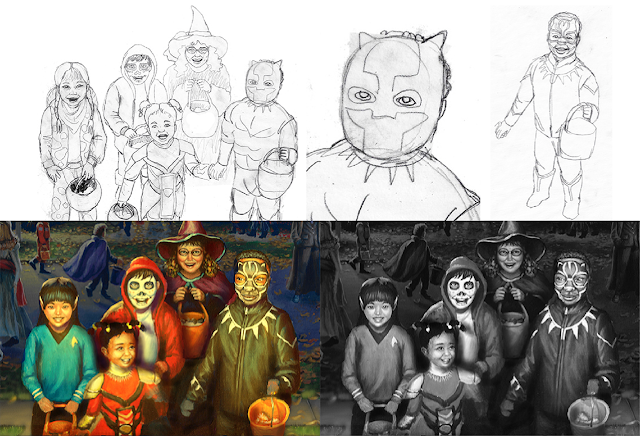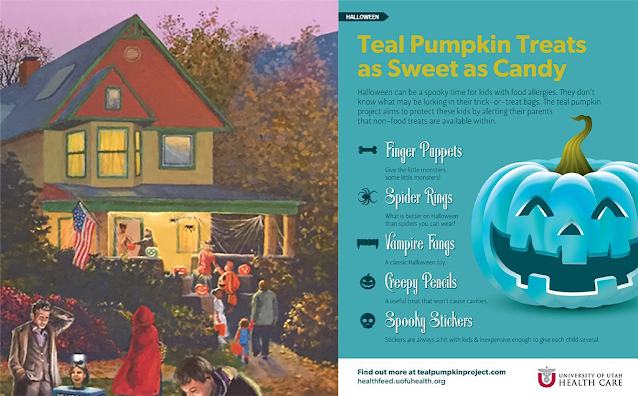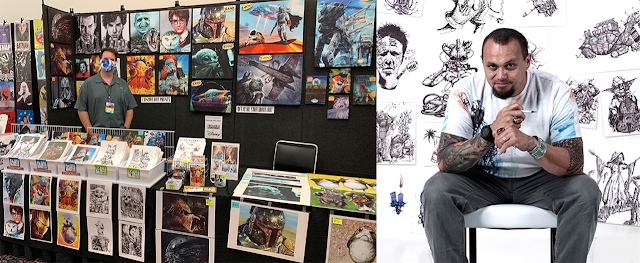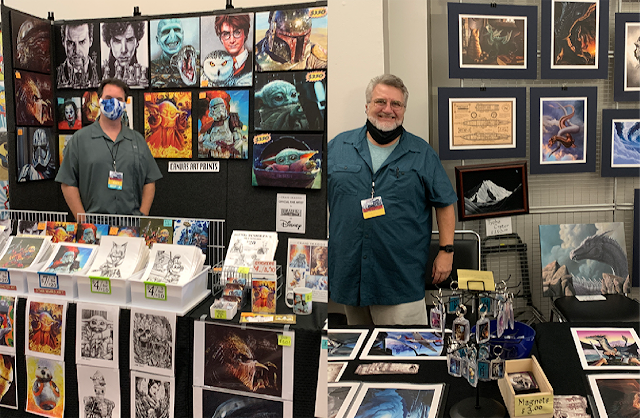By Jan S. Gephardt
“Rejoicing in our Differences” is a new series of larger-scale paintings by my friend (and frequent XK9-painter) Lucy A. Synk. The theme also could be an unofficial motto for Weird Sisters Publishing. Yes, Lucy, G., and I are all white women of a certain age. You might not look at us and instantly think “diversity!” But all three of us are creative types who both value, and seek to nurture and celebrate, diversity.
Privileged in some ways? Certainly. It comes with the skin, whether we like it or not. Had it easy? Well, we’re all women. We’ve spent decades bumping into patriarchy, in male-dominated creative fields (name one that isn’t), and earning lower wages than men. Make of that what you will. But diversity isn’t a contest. And this isn’t a story about who’s more “oppressed.”
It’s an invitation to celebrate, to ally with others, and to spend a little time rejoicing in our differences. In the spirit of the season, please spend a little time looking at Oak Park Halloween.
 |
| The full painting Oak Park Halloween, 2019, by Lucy A. Synk. |
Every Painting is a Journey
Lucy’s journey to creating this painting took her through job changes, moves from state to state, and a bout of homesickness for a beloved place she’d had to leave. For a while she had an illustration job in Chicago, and she settled happily into the suburb of Oak Park, Illinois. There she found friends, a compatible faith community, and a place of architectural and natural beauty.
Even after she had to relocate, the fond memories lingered. And they fed an idea for a painting. No, a series of paintings. In 2018, before SARS-CoV-2 had even hinted at darkening our horizon, she began to build on her ideas for a series of paintings that explored the many ways in which the United States has ample reason to rejoice in our differences.
As she says in her artist’s statement, “Even more importantly than providing entertainment or decoration, art should also inspire, teach, and encourage people to think, wonder and grow. My work often has symbolic or fantasy elements without fitting any single category but reflects my search for unity in the diversity not only of my own interests, but in the plurality of American culture.”
A Sharp Break with Disunity and Hatred
Oak Park Halloween draws on Lucy’s memories, but it’s not meant to be taken as history. The painting was specifically inspired by one particular Halloween in her diverse, family-friendly neighborhood in Oak Park, IL. But the painting does not portray any specific street or group of people. She was hoping to evoke a feeling of Halloween fun that many can relate to and enjoy.
In today’s political climate, that almost makes it a radical protest painting. “Rejoicing in our Differences,” as a message, cuts sharply counter to the majority of things we see in the media these days.
As I write this, they’re doing jury selection in Georgia, for the trial of three men who are using a fugitive slave law from 1863 as their defense for killing Black jogger Ahmaud Arbery. White supremacists are going on trial in Charlottesville, VA, for civil rights violations stemming from a the 2017 “Unite the Right” rally that led to the death of counter-protester Heather Heyer. And hate crimes are at a shocking high.
But just because Americans don’t seem to be rejoicing in our differences right now, that doesn’t mean the message isn’t important. Some (me, for instance!) might say it’s more important now than ever. That said, let’s walk through Oak Park Halloween.
 |
| You might notice a bunch of changes to details through these varied steps in the development of the painting. The black-and-white tonal study at lower right was done to check contrast and value range. (Images are © 2018-2019 by Lucy A. Synk). |
How do you Paint a Crowd Scene?
Of all the things in the world that there are to draw, people are by far the hardest, especially for untrained artists. Even trained ones can have difficulty. We come pre-loaded with a lot of ideas that have nothing to do with how humans (or other things) look in objective reality. Which is why the proportions in kids’ drawings are so frequently distorted.
And if you think one human is hard, just wait till you tackle a crowd scene!
Take another look at Lucy’s painting above. Yes, it is a tour de force. But how does an artist manage a crowd scene? It’s kinda like eating the proverbial elephant “one bite at a time.” Except, in this case it’s drawing (and then painting) one small group at a time.
 |
| The brother and sister in front portray Marvel’s Black Panther and one of his elite Dora Milaje, the Wakandan royal guards. We have a Vulcan Starfleet Science Officer from the Star Trek Universe to the front girl’s left. The child in the red hoodie portrays Coco, from the movie of the same name, and the girl in the purple witch costume might be portraying Hermione Granger. Since masks tend to obstruct kids’ ability to see, in this pre-Covid painting, these children wear face paint, rather than masks. (Image © 2019 by Lucy A. Synk). |
The Porch Kids
In the front-center of the composition, a group of five kids appear larger than the others, many of them staring directly at the viewer. They’re there to both center and focus the painting, and to invite you into it. The idea is that they’re standing on the viewer’s porch, awaiting your interaction and generosity.
As the most prominent group, they also are the most diverse, in keeping with the overarching theme of rejoicing in our differences. Since kids normally trick-or-treat in friend groups, how might these kids have met and formed friendships? I bet you’re already imagining a story for them—exactly as the artist hoped you would.
Lucy did a lot of research to create each group in the painting. Many of the costumes are based on DIY (do-it-yourself) outfits she found online, or combinations of them. She also took some important (pre-Covid) safety concepts into consideration. For example, since masks tend to obstruct kids’ ability to see, these children wear face paint, rather than masks.
 |
| These are just some of the developmental sketches and studies Lucy worked through for the “Porch Kids” group. (All images © 2018-2019 by Lucy A. Synk). |
Fantasy and Science Fiction Elements
Lucy and I met at a science fiction convention. A deep, abiding interest in these genres continues to be an important part of our lives, even outside of the field. Oak Park Halloween isn’t meant to be a “fantasy genre” painting in the way that some of Lucy’s work has been. But with fantastical elements dominating popular culture, of course she made sure there was broad representation for many beloved stories.
Thus, you’ll find Star Trek, Star Wars, the Marvel Universe, the DC Universe, Dr. Who, and others among the more traditional witches, vampires, fairy princesses, and caped heroes. Lucy also came down rather heavily on the side of DIY costumes. Not only did she want to avoid infringing copyrights, she wanted to celebrate parental ingenuity while “rejoicing in our differences.”
 |
| From left to right, (1) The Jedi Knight and his little sister (on the Tauntaun) portray characters from the Star Wars Universe. The child with the pink bag is meant to be a vampire. However, her tiny fangs do not show, since her whole body is only 7” high. (2) A little astronaut, in the actual painting about 3½” tall, wears an orange, NASA-style jumpsuit. The artist is inspired by all the little girls who yearn for such future careers. (3) The child dressed up as the T.A.R.D.I.S. is based on a popular DIY costume concept that proves particularly confusing to her observer—a nod to Dr. Who, as portrayed by “Tenth Doctor” David Tennant. (4) A toddler enjoys a first Halloween, guided by Dad. The DIY costume uses glow sticks to create a light-up “stick man” from a black, hooded onesie. (5) Wonder Woman and her parents Hippolyta and Zeus are based on the artist’s great-niece and her parents, for whom themed family costumes are a tradition. (All images © 2019 by Lucy A. Synk). |
Getting the Details Right
Having been an “inside observer” of the two-year development process from early sketches to finished painting, I can tell you a lot of thought went into those houses across the street. Based on architecture in Oak Park IL they might be, but none of them is an exact portrait of an existing house. As with the kids they host, they are “of the general type.” But each one tells its own story.
You might be surprised at the care given to small details, such as placement, size, and color of the moon. The exact moment of twilight, and how to paint it, inspired another spate of thinking and second-guessing.
For an artist, the light has to be just right. If it’s off, or if a shadow falls wrong, the illusion fails. We often hear about the “willing suspension of disbelief” that’s necessary for a reader to self-immerse into a story. But to appreciate a painting we also need to willingly suspend our disbelief that this collection of light and dark color splotches “is” the frozen moment in time it purports to be. One wrong shadow or highlight can ruin it.
 |
| Sketches and color studies offer a glimpse of Lucy’s decision-making, and the thorny question of how big and where to position the moon. (All images © 2018-2019 by Lucy A. Synk). |
Homes that Harbor no Hate
As I noted above, each of the houses “across the street” tells its own story. I like to think of them as the “Hate Has No Home” House, the “Welcome to All” House, and the “Teal Pumpkin” House. Each embodies a sub-thread of the overall “rejoicing in our differences” theme.
 |
| The yellow house at upper left in the painting is haunted by a fairly traditional group. We have several princesses, ghosts and a pumpkin-head. Some might recognize the sign in the window as a “Hate Has No Home Here” sign, shown at right. (House image © 2019 by Lucy A. Synk. Sign by Hate Has No Home Here). |
 |
| We have Batman, the Cowardly Lion, another witch, and assorted other traditional costumes at the middle house. The host couple in the doorway are a mixed-race pair, typical of a growing number of American families. The group on the sidewalk to the right portray an assortment of Pirates of the Caribbean. The quote is from Lucy’s Artist’s Statement about her “Rejoicing in our Differences” series. (Image © 2019, and words © 2021 by Lucy A. Synk). |
 |
| The children at the house with the orange gables in the painting’s upper right include a portrayal of Princess Leia. Note the Teal Pumpkin on the porch, which indicates that this house gives prizes suitable for children with food allergies. Rejoicing in our differences includes making a happy, accepting place for everyone, even if they face special challenges. (House image © 2019 by Lucy A. Synk. The “Teal Pumpkin Treats” graphic is courtesy of University of Utah Health Care, via Pinterest). |
Rejoicing in Our Differences
Lucy certainly recognizes that her “Rejoicing in our Differences” theme asserts an aspirational goal. But then, she’s lived a life of diverse inputs and challenges. She started with a BFA in Drawing, Painting, and Photography from a small college, then pursued an art career that included a stint at Hallmark Cards, freelancing as a fantasy artist, and work as a natural history illustrator and muralist.
“My work has always been very diverse, spanning multiple mediums and subject matters,” she says. As both natural and human history has shown, diversity makes a system stronger, even if not everyone is comfortable embracing differences. The most vibrant, creative, and innovative times and places have come at a crossroads of cultures, when diverse ideas and viewpoints make new ideas possible.
As Lucy wrote in her artist’s statement, “In these dark times, there has been so much negativity.” Perhaps you’ll agree that we’d do better to meditate on what Lucy calls America’s “wonderful diversity.” Based on that, “Rejoicing in Our Differences” may be exactly the medicine we need.
IMAGE CREDITS
Oak Park Halloween, the painting, the studies, the sketches, and the detail images, all are © 2018-2019 by Lucy A. Synk, and are used here with her permission. All rights reserved. The “Hate Has No Home Here” poster design is courtesy of Hate Has No Home Here. The “Teal Pumpkin Treats” graphic is courtesy of University of Utah Health Care, via Pinterest. Many thanks to all!






















